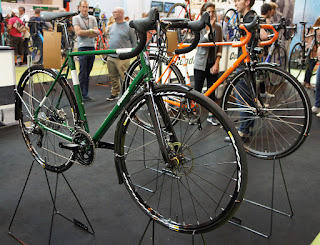TRP Spyre mechanical disc brake is
widely recognised as being the best mechanical system going and little surprise
they were a popular site at last week’s Cycle show. Numb of bum and brain, I
took a break from deadlines and fitted mine to the Ilpompino on Tuesday
afternoon. Twenty minutes, a new inner wire, some perfectionist re-wrapping of
the bars and shot of PTFE lube later, we were ready for the lanes.
I’ve always rated Avid’s BB7 but the
spyre’s just a much nicer system full stop.
Both have been popular sights on the
cyclo cross scene for a few years now, although they are fundamentally
different designs. The Avids are a single piston design, whereas the Spyre uses
two, meaning braking force is shared equally between both pads, which are
effortlessly adjusted via the barrel adjuster (or from the bars in a race
context). Single piston adjustment requires dismounting, annoying on a long
winter ride but potentially the difference between first and second on a muddy
race circuit.
Correctly set up, this ensures
uniform pad and rotor wear. With a compression-less cable, like for like, the
Spyre feels marginally more powerful but modulation and feel are the greatest
improvements. I also prefer the sleeker profile, which may offer some
negligible aero advantage but bereft of wind tunnel facilities, I’ll settle for
a sharper aesthetic and 20g saving.
Darker nights are seeing a procession
of high power blinkies and main systems, including Moon’s shield X auto. It’s a
sophisticated 9 mode model with a maximum output of 80 lumens and
interestingly, a light sensitive auto on/off setting. This gives the option of
the light engaging via a sensor, once the light dips beyond a certain level.
Not a new concept; Shimano’s nexus dynamo switch and several others have used
similar technology, although admittedly, its comparatively rare on safety
lights.
Arguably and it its simplest, all
you’ll need is two functions-constant and flashing but I’ve always liked a
selection, of varying output and patterns. There are four steady and four
flashing, with another daylight setting. Thankfully a mode memory means it
defaults to your last choice, which makes life easier, especially if you have a
favourite.
Rule of thumb says 15-20 lumens is
more than sufficient for urban riding. Rural contexts call for something
brighter.
Specification is comparable with
other bells n’ whistles models. COB (Chips on Board) technology means diodes
are placed directly onto the circuit board, thus creating a more intense
pattern of light.
In this instance the Cree XPE+ diode
is joined by another 20. A CNC machined aluminium casing serves as a heat sink,
keeping them cool, for a long and productive life. Lens and reflector quality
have a big part to play, this casts a 270 degree cloak of light, which gives
plenty of peripheral presence, while the collimator lens projects a very strong
spot to nail the attention of approaching traffic.
I’ve used and been suitably impressed by the original Shield and formative impressions suggest this version is a very capable safety light but we’ll have more to say a few weeks down the line.
I’ve used and been suitably impressed by the original Shield and formative impressions suggest this version is a very capable safety light but we’ll have more to say a few weeks down the line.
I’ve also taken delivery of this four
mode, Xeccon Zeta 1300 lumen front light, which the Chinese marque claims is
designed for both mountain biking and city riding. The diminutive lamp is
nicely executed from CNC machined aluminium alloy for durability and heat
dispersing qualities.
This meets IPX6 for weatherproofing,
meaning water-resistant unless fully immersed and houses a single Cree XHP50
diode and switch. This attaches to the bars via a surprisingly neat bracket,
slightly reminiscent of Go Pro types and choice of sturdy O rings.
As we’ve come to expect, there’s also
a helmet mounting option and the 8.4volt 5200aMH battery pack is both smaller
and lighter than photos suggest. This is reckoned to fuel the light’s 1300 lumen
mode for a very respectable 3.5 hours, although a full charge means 5 hours and
30 minutes-from the mains. Looking at the couplings, I am fairly confident that
other, pattern packs are interchangeable.
Technically, the neoprene carry sack
will play nicely with a top tube bag; though in the Ilpompino’s case, I’ve
substituted mine for the cavernous Axiom Grand Fondo wedge pack.
Depressing the lamps’ positive centre
mounted switch for two seconds brings it to life, subsequent presses cascade
through the settings. This also employs the familiar traffic light battery-life
indicator and it’s perfectly aligned within rider eye-line. There’s also a remote wireless trigger for
convenience.
First impressions-a quick hour’s
blast along the lanes, suggests a good hybrid spot/flood combining sufficient
navigational clout for serious speed with a decent arc providing presence a
plenty. Unlike the ubiquitous auction site specials, lens and reflector quality
means there’s no dazzling of rider or other road users.
Other traffic, including SUVs have
dips their beams from full to main at car typical distances too. I was surprised by how warm the casing had
become during the ride but then again, we’re not in digit singing territory. For now, I'll leave you with a link to some footage...https://www.facebook.com/Sevendaycyclistmagazine/videos























































